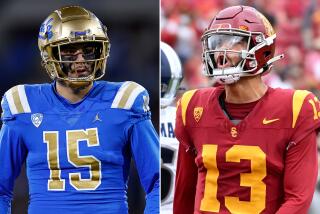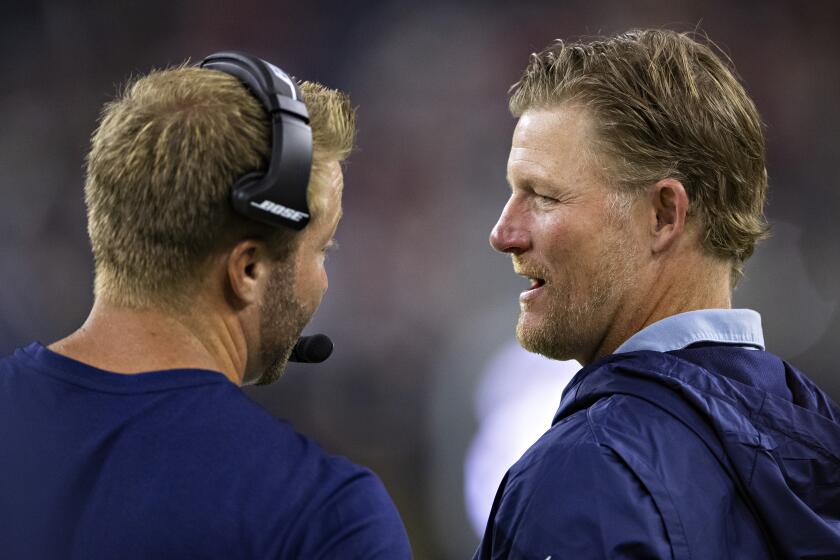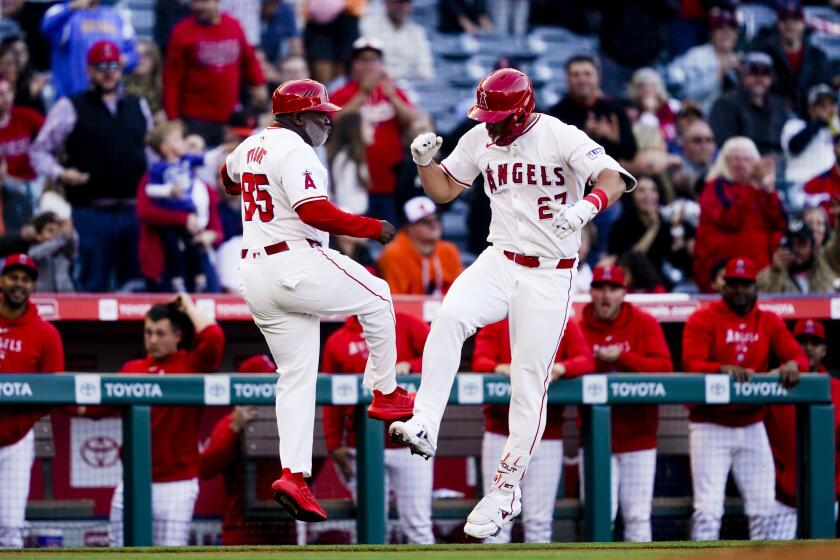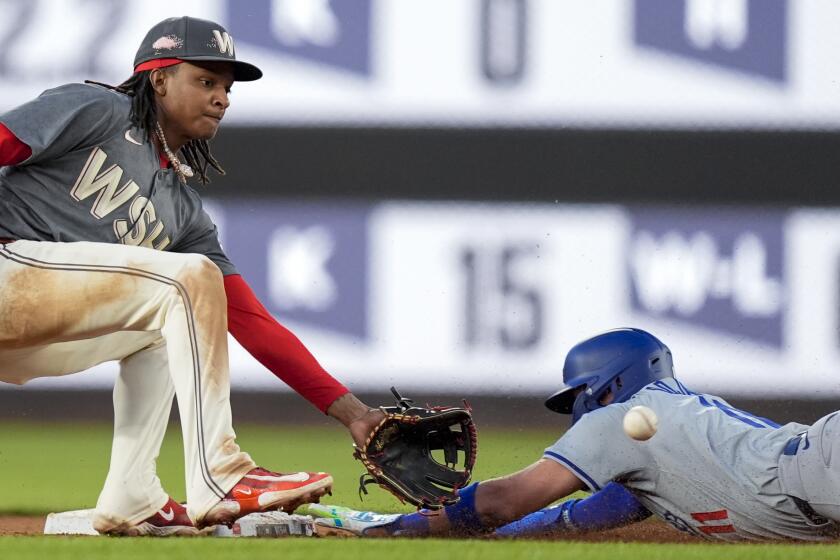NFL is taking the long-term impact of concussions seriously
Kyle Turley was 6 feet 5, 309 pounds, with hydrant-thick arms covered in tattoos. He was among the meanest, toughest offensive linemen in the NFL.
And he was out cold.
He had taken a shot to the helmet when playing for the St. Louis Rams in 2003 and was briefly unconscious. He quickly came to and made his way to the sideline, yet was so disoriented that when he tried to wave to his wife to let her know he was OK, he couldn’t remember where she was sitting.
“I should have remembered that,” Turley said. “We bought a luxury box that cost $50,000. It was right over my left shoulder. That’s where it was at and always would be, and had been all the games before that. I just kept looking around the stadium.”
The truly scary part was still to come. Even though he suffered a severe concussion — one doctor said later that he should have been sidelined for a month —Turley says he was encouraged by team trainers to return to practice three days later. It was the kind of thing that many brain-injury experts now believe could have long-term effects on mental health.
“I came in and [the trainers] said, ‘How do you feel now? Because you’ve got to practice today if you’re going to play in the game,’ ” said Turley, who retired in 2007. “I was like, ‘Well … I’ve got a little bit of a headache still, but it’s getting better.’ And they’re like, ‘OK, good! We’ll clear you to practice today. We’ll watch you.’ ”
That was not so much a specific indictment of the Rams’ medical staff, but of the widely embraced football philosophy from the NFL on down: If you could see straight, you were good to go.
After years of denying a link between multiple concussions and long-term cognitive decline, the NFL is finally taking an aggressive approach to the problem. Various studies have shown:
• More than half of NFL players say they have had a concussion on the field, and one in four recall having at least three.
• Former players have been diagnosed with Alzheimer’s disease or similar memory-related afflictions at five times the rate of people who didn’t play.
• One in five players who have had multiple concussions say they have suffered depression — three times the rate of players who say they haven’t suffered concussions.
“If you look at the diseased brains, I think there’s no question that we’ve been playing the game of football wrong,” said Chris Nowinski, a former Harvard defensive lineman who has done groundbreaking research on the long-term effect of concussions. “The game has evolved into something it was never intended to be. It’s evolved into intentional helmet-to-helmet hits. It’s evolved into 1,000 hits a year. It’s evolved into skull-fracturing forces that are protected by a thin piece of plastic, so your skull doesn’t get fractured but your brain still absorbs the force.
“It’s evolved from a game that used to be about moving the ball, to one that’s about highlight-film hits.”
There have been studies for decades that link multiple concussions and cognitive erosion. At long last, under increasing pressure from lawmakers, former players and medical experts, the NFL has begun to get proactive.
“We need to make the game safer,” NFL Commissioner Roger Goodell said. “We have more work to do, but we think we’re making progress and we’re changing the culture.”
According to a league-commissioned study last year, Alzheimer’s disease or similar memory-related afflictions seem to have been diagnosed in former NFL players at a vastly higher rate than the national population. The study, conducted by the University of Michigan’s Institute for social research, reported that 6.1% of former players age 50 and older reported they had received a dementia-related diagnosis, five times higher than the cited national average of 1.2%.
The information was gathered in phone interviews with 1,063 retired players, each of whom had played at least four seasons in the NFL. A league spokesman pointed out the study did not formally diagnose dementia, and questioned the reliability of phone surveys.
Still, the emerging information about head injuries is chilling to many current and former players.
“None of this was ever told to us,” Turley said. “The NFL never talked about it. The general public never talked about it. It’s just because of neglect and ignorance. There could have been so much study and research done on this issue. And now we’ve finally got doctors who are getting their voice heard.
“They have knocked on the NFL’s door many times. It’s just never been opened for them before.”
Congressional pressure helped spark the change. Last October, Goodell and NFL Players Assn. Executive Director DeMaurice Smith, along with doctors and former players, testified on Capitol Hill in an attempt to identify how to make football safer. Judiciary Chairman Rep. John Conyers, D-Mich., said the issue warranted congressional review.
Three weeks later, Goodell approved the resignation of Dr. Ira Casson and Dr. David Viano, who had led the league’s committee on concussions since 2007.
Then came more changes. In December, the NFL banned players from returning to a game or practice the same day they exhibited signs of a concussion, and ruled they must be fully asymptomatic — when at rest and active — before being cleared to come back. Also, the league said, clearance should come from a doctor not employed by the team.
Players are now asked to track and report their own head injuries, and tell on other players who might be masking symptoms.
“It almost has to be a whistleblower mentality, unfortunately,” Cleveland Browns linebacker Scott Fujita said. “If you have a teammate and you see that he’s kind of dinged and having some problems, you have to be a good, responsible teammate and report that. As much as a guy might not want to hear it, it’s up to us to take the onus on ourselves and be responsible.”
The league donated $1 million to Boston University’s Center for the Study of Traumatic Encephalopathy’s research into the long-term effects of repetitive brain trauma in athletes, particularly in football players. The NFL was the first sports league to financially support that research at the school.
This season, for the first time, all 32 locker rooms feature posters warning about the danger of concussions.
“Use your head. Don’t lead with it,” the signs read, adding that “repeated brain injury can change your life and your family’s life forever.”
That’s an abrupt departure from the position of the ousted Casson, who had been widely criticized during two House hearings for his repeated denials of any link among retired players between brain injuries sustained and heightened rates of dementia.
The new posters and brochures replace pamphlets distributed to players since 2007 that read: “Current research with professional athletes has not shown that having more than one or two concussions leads to permanent problems if each injury is treated properly,” and left unanswered the question of “if there are any long-term effects of concussion in NFL athletes.”
That might sound preposterous, but according to Dr. Vernon Williams, neurologist at the Kerlan-Jobe Orthopaedic Clinic in Los Angeles, connecting the dots between concussions and long-term cognitive decline is not as simple as it sounds. He said other variables, such as chronic pain, can also contribute to cognitive decline. That makes it difficult to pinpoint concussions as the culprit.
But he added: “There are certain things that I don’t think anyone would disagree with, and that is that every concussion is serious. That’s actually a big step. Because at one point we said, ‘Hey, if you’ve got a mild concussion, go ahead and play in the same game because for all we can tell, everything is resolved within 15 minutes, the brain seems to be working pretty well, there doesn’t appear — or didn’t at that point — to be any risk of returning to play.
“Now, everyone, the NFL included, says that’s not safe.”
For the first time, all 329 NFL hopefuls invited to the scouting combine were given a baseline brain activity exam, called the ImPACT test, and faced questioning from teams about their concussion histories.
Goodell replaced Casson and Viano in March with Dr. H. Hunt Batjer, the chairman of neurological surgery at Northwestern Memorial Hospital in Chicago, and Dr. Richard G. Ellenbogen, chief of neurological surgery at Harborview Medical Center in Seattle. The panel was rechristened the NFL’s head, neck and spine medical committee.
According to a survey of 1,090 former NFL players in 2000, more than 60% had suffered at least one concussion, and 26% had had at least three. The players who suffered more reported more problems with memory, concentration, headaches and other neurological issues than those who had not.
A concussion doesn’t always result in a loss of consciousness, and often is marked by a vacant stare, confusion, delayed verbal and movement skills, memory loss, slurred speech, and overly emotional responses.
Nowinski, for one, questioned how any football player could get as far along as the NFL and not suffer a concussion along the way.
“In college, when we had two-a-days at the beginning of the year, everybody’s head throbbed — everybody,” he said. “By the second week, you felt like you were going to throw up every time you got into a three-point stance. It’s funny how normal we thought that was. We just thought we were getting used to hitting again.
“The reality is we all probably had been concussed and we were playing through it.”
In 2007, a study conducted by the University of North Carolina’s Center for the Study of Retired Athletes surveyed 595 former NFL players who had sustained three or more concussions. Of those players, 20.2% said they had been found to have depression — about three times the rate of concussion-free players.
After Cincinnati Bengals receiver Chris Henry died as a result of a traffic accident last year, researchers at West Virginia University discovered he had chronic traumatic encephalopathy, or CTE — a form of degenerative brain damage caused by multiple hits to the head — at the time of his death. He had never missed a game because of a concussion.
A neuropathologist from Boston University, associate professor Ann McKee, released findings earlier this month that linked traumatic brain injuries and amyotrophic lateral sclerosis, better known as Lou Gehrig’s disease. The significant study, which Nowinski assisted in, was chronicled on HBO’s “Real Sports.” Having studied the brains of a dozen deceased contact-sport athletes, the BU researchers determined all 12 showed signs of CTE.
Some experts say that most long-term harm is not caused by a single, highlight-reel concussive blow, but by years of smaller helmet thumps, sometimes called “sub-concussive” hits. One study says about 75% of concussions happen during practice as opposed to games.
“That HBO special was alarming,” Fujita said. “It’s scary to think that those sub-concussive hits might be the biggest problem. Think about those offensive and defensive linemen. They might not have the huge impacts like a safety or a linebacker or a running back. But every game they might have 50 or 60 taps on the helmet — bang, bang, bang — and that’s alarming for everybody.”
Changing football’s culture is no easy task. Throughout the sport’s history, concussions have been an accepted reality of the game. Unlike a more obvious wound such as a bone protruding from the skin, brain injuries are usually subjective and harder to detect. Then, there’s the longstanding just-rub-some-dirt-on-it-and-get-back-out-there attitude.
“When you start talking about the concussions and things like that, there’s just so much information now and it’s such a new thing that I think they’re still trying to discover what the heck is a concussion,” said 49ers Coach Mike Singletary, a Hall of Fame Chicago Bears linebacker who says he never suffered one.
“I just think back right now, when we were playing, you would just go out there and play, and they would put smelling salts in front of you, and you would just smell that and go back out there and play if you can walk.
“You hold up two fingers and you say, ‘Two-and-a-half,’ and you’re close enough, let’s go. That’s pretty much how it was.”
Williams predicted that in the coming years there will be increased attention not just on concussions but sub-concussive impacts — the simple knocking of heads — and how much is too much.
“I’m interested in the impacts the brain has sustained, where the player — and the trainers — didn’t notice any significant decline in their functions, but is there a threshold where those impacts increase risk of long-term neurologic decline?” he said. “Do we need to continuously monitor cognitive function? There’s a ton of work to do.”
Although there is no way to legislate concussions out of football, the NFL is investigating ways of reducing the risks with better equipment, possible practice restrictions, rules changes relating to how “defenseless” players can be hit, and more fines levied against violators.
In his role as special advisor to the commissioner, John Madden chairs a committee of coaches exploring ways of providing players with a safer practice environment. Among the considerations are limiting contact in practices — maybe by limiting the use of helmets — and reducing the overall amount of offseason work.
Still, football is a violent sport, and current players frequently say they simply cannot do their jobs effectively if preoccupied by the possibility of a concussion.
“You’ve got to be able to play the game at 100 mph with reckless abandon,” Indianapolis defensive end Dwight Freeney said. “You could get out there and play half-stepping, but you’re not going to be as effective and it will probably show.”
Former Arizona Cardinals quarterback Kurt Warner, 39, who suffered several concussions over the course of his career, finally called it quits after last season — even though he says he felt good enough to keep going. Concussions tipped the scales in that decision.
“I’ve got the rest of my life in front of me,” he said. “I’ve got seven kids I have to raise. Football is a great career. But you can’t jeopardize your life for this game.”
Agent Leigh Steinberg, who once represented about half of the NFL’s starting quarterbacks, has a vivid memory of sitting in a Dallas-area hospital room with Troy Aikman, hours after the Cowboys quarterback led his team to a victory over San Francisco in the 1993 NFC championship game.
As all of North Texas was awash in celebration, Steinberg had to repeatedly inform a bewildered Aikman that he was A) at Baylor Medical Center, and B) had just directed his team to the Super Bowl.
So disturbing was the experience, that Steinberg became an activist on the issue of concussions and began a series of player-safety conferences in the 1990s.
“It’s one thing for a football player after a career of injuries not to be able to pick up his child,” Steinberg said.
“It’s another thing not to be able to recognize that child.”
sam.farmer@latimes.com
twitter.com/LATimesfarmer
More to Read
Get our high school sports newsletter
Prep Rally is devoted to the SoCal high school sports experience, bringing you scores, stories and a behind-the-scenes look at what makes prep sports so popular.
You may occasionally receive promotional content from the Los Angeles Times.







